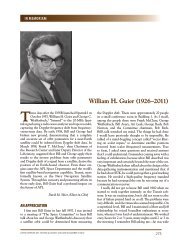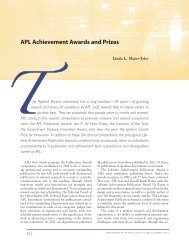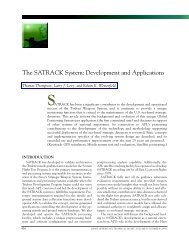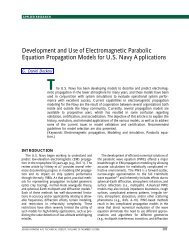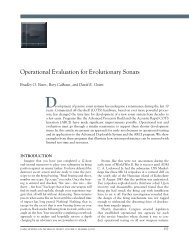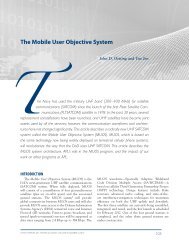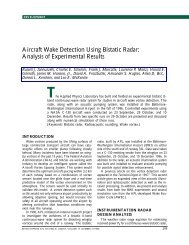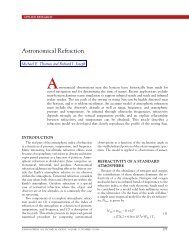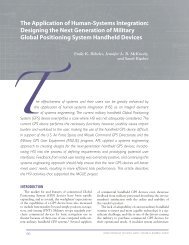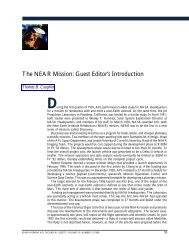A Practical Application of Relativity to Observation and Control of ...
A Practical Application of Relativity to Observation and Control of ...
A Practical Application of Relativity to Observation and Control of ...
Create successful ePaper yourself
Turn your PDF publications into a flip-book with our unique Google optimized e-Paper software.
The spacecraft actually contains four oscilla<strong>to</strong>rs that<br />
can be used <strong>to</strong> support onboard timekeeping. The current<br />
configuration <strong>of</strong> the spacecraft avionics allows either<br />
<strong>of</strong> two <strong>of</strong> those oscilla<strong>to</strong>rs <strong>to</strong> be used <strong>to</strong> drive the MET<br />
counter. One is a very stable oven-controlled crystal<br />
oscilla<strong>to</strong>r (OCXO) that is used <strong>to</strong> provide the timekeeping<br />
system accuracy required <strong>to</strong> support science observations.<br />
Owing <strong>to</strong> reliability concerns, however, the other<br />
less-stable “coarse” oscilla<strong>to</strong>r is used <strong>to</strong> drive the MET<br />
counter whenever an engine burn is performed. This has<br />
occurred numerous times—during cruise, during Mercury<br />
orbit insertion (MOI), <strong>and</strong> also at many solar perihelia<br />
<strong>and</strong> aphelia while the spacecraft is in orbit around<br />
Mercury. This occasional deselection <strong>of</strong> the “precision”<br />
oscilla<strong>to</strong>r, the OCXO, has produced numerous gaps in<br />
our record <strong>of</strong> OCXO performance. Even with those<br />
gaps, however, some very interesting <strong>and</strong> useful information<br />
has been gathered about the behavior <strong>of</strong> the OCXO<br />
<strong>and</strong> <strong>of</strong> the timekeeping system itself.<br />
The timekeeping system produces, on the ground,<br />
an estimate <strong>of</strong> the correlation between MET <strong>and</strong> Earth<br />
time in terms <strong>of</strong> the TT system. It saves that estimate<br />
in a text file called the Operations SCLK (Spacecraft<br />
Clock) Kernel. The SCLK Kernel estimate <strong>of</strong> clock<br />
behavior directly maps <strong>to</strong> average oscilla<strong>to</strong>r behavior.<br />
When the OCXO is selected, comparison <strong>of</strong> that average<br />
oscilla<strong>to</strong>r behavior <strong>to</strong> how we would predict the<br />
oscilla<strong>to</strong>r <strong>to</strong> behave according <strong>to</strong> the special <strong>and</strong> general<br />
theories <strong>of</strong> relativity provides us with knowledge <strong>of</strong> how<br />
much the OCXO behavior deviates from those predictions.<br />
Those “residuals” tell us how the physical OCXO<br />
actually behaves, as a local observer on the spacecraft<br />
would see it. Trending those residuals allows us <strong>to</strong> predict<br />
how the OCXO will behave in the future, <strong>and</strong> that<br />
prediction, in turn, is routinely used by the MESSEN-<br />
GER Mission Operations Center at APL <strong>to</strong> control the<br />
onboard real-time estimate<br />
<strong>of</strong> Earth time (TT) used by<br />
the G&C subsystem. 2<br />
The MESSENGER timekeeping<br />
system has not<br />
only provided us with the<br />
practical result <strong>of</strong> accurate<br />
onboard time for the G&C<br />
subsystem but has also provided<br />
a rare opportunity<br />
<strong>to</strong> have a glimpse, however<br />
small, in<strong>to</strong> the theoretical<br />
universe <strong>of</strong> Albert Einstein.<br />
THE VENUS FLYBY IN 2007<br />
In early 2007, the MES-<br />
SENGER spacecraft began<br />
<strong>to</strong> use the oscilla<strong>to</strong>r designated<br />
OCXO-B <strong>to</strong> control<br />
the spacecraft clock. Shortly<br />
Frequency <strong>of</strong>fset (clock drift rate) (ppb)<br />
35<br />
30<br />
25<br />
20<br />
15<br />
10<br />
5<br />
Actual MET drift rate<br />
Residual clock drift rate<br />
MET drift rate minus velocity effect<br />
afterward, the spacecraft had its second flyby <strong>of</strong> Venus<br />
<strong>to</strong> provide a gravity-assisted course correction on its<br />
long journey <strong>to</strong>ward Mercury. The variation in OCXO<br />
behavior that was evident from the behavior <strong>of</strong> the MET<br />
counter as estimated in the Operations SCLK Kernel<br />
was much greater than we had seen during testing on<br />
the Earth <strong>and</strong> was much greater than could be explained<br />
by environmental fac<strong>to</strong>rs such as the sensitivity <strong>of</strong> the<br />
OCXO output frequency <strong>to</strong> temperature variations. The<br />
explanation lies in the theory <strong>of</strong> relativity, which tells us<br />
that both velocity <strong>and</strong> gravity can measurably affect the<br />
observed behavior <strong>of</strong> a distant clock or oscilla<strong>to</strong>r. Time,<br />
according <strong>to</strong> the theory, is not the same for all observers.<br />
<strong>Observation</strong>s during the 2 months after the OCXO<br />
was selected, including the closest approach <strong>to</strong> Venus<br />
during the second MESSENGER flyby <strong>of</strong> Venus, are<br />
illustrated in Fig. 1. The observed OCXO fractional<br />
frequency <strong>of</strong>fset (bot<strong>to</strong>m curve) varied by 11 parts per<br />
billion (ppb), much more than we had observed during<br />
ground testing. That is equivalent <strong>to</strong> a variation in the<br />
MET counter <strong>of</strong> 11 ns/s or 0.95 ms/day. This OCXO was<br />
cus<strong>to</strong>m designed <strong>to</strong> limit sensitivity <strong>to</strong> environmental<br />
fac<strong>to</strong>rs <strong>and</strong>, for example, was designed <strong>to</strong> allow only<br />
4 ppb OCXO fractional frequency variation or 0.35 ms/<br />
day over the full 40°C operational temperature range.<br />
Also, the oscilla<strong>to</strong>r experienced a temperature variation<br />
<strong>of</strong> only 4°C during the Venus flyby. The frequency<br />
changes that we observed were much greater than environmental<br />
variations could cause.<br />
Let’s focus first on the effect <strong>of</strong> velocity on the oscilla<strong>to</strong>r<br />
frequency performance. Special relativity tells us that<br />
time on the spacecraft (the MET counter) is related <strong>to</strong> the<br />
time perceived by a distant observer by the Lorentz fac<strong>to</strong>r<br />
= 1/ [1 − (v 2 /c 2 )] 0.5 , where c is the speed <strong>of</strong> light <strong>and</strong> v<br />
is the magnitude <strong>of</strong> the velocity <strong>of</strong> the spacecraft in the<br />
coordinate frame <strong>of</strong> the distant observer. Because oscil-<br />
0 960 970 980 990 1000 1010 1020 1030 1040 1050<br />
Days since launch<br />
Figure 1. Residual MESSENGER OCXO-B behavior after March 2007 turn-on.<br />
JOHNS HOPKINS APL TECHNICAL DIGEST, VOLUME 32, NUMBER 1 (2013) 389





